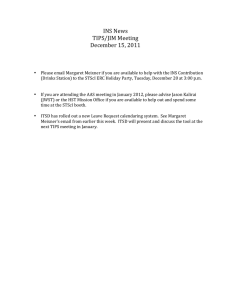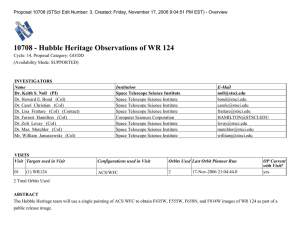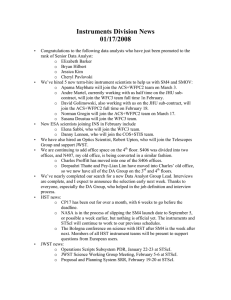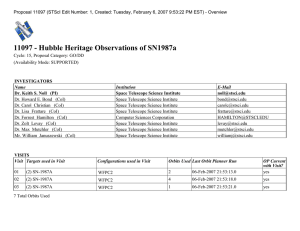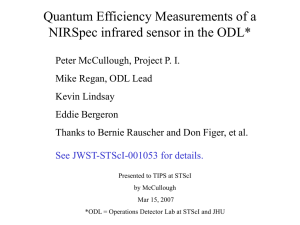Effective Management of Information Technology for Multi-Mission Organizations
advertisement
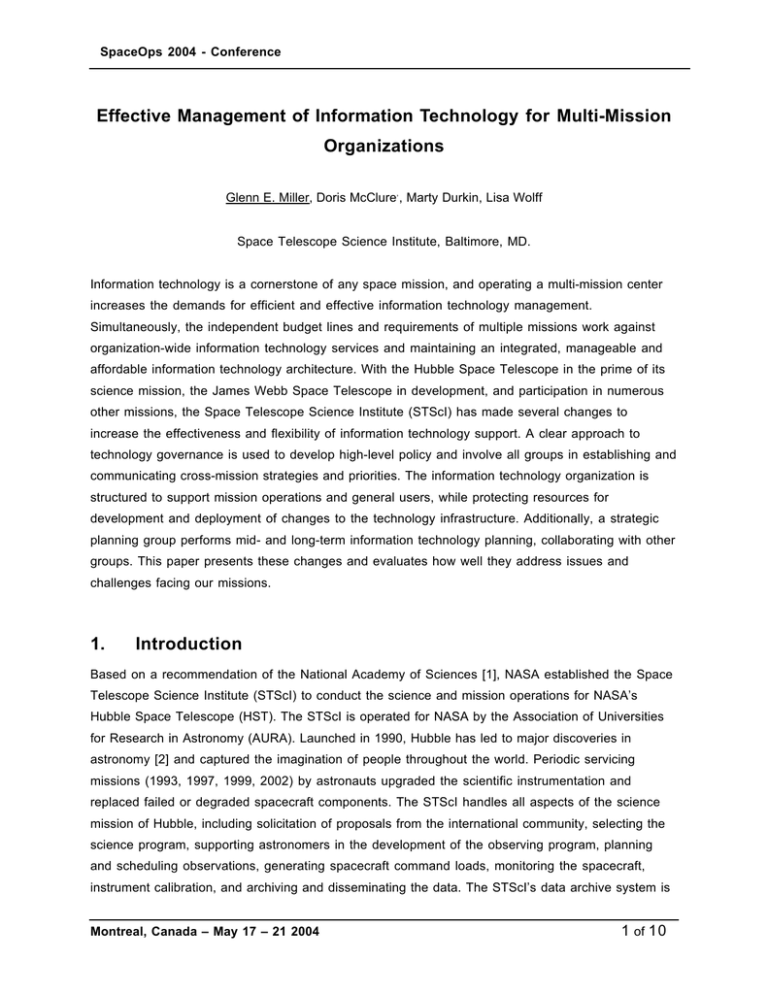
SpaceOps 2004 - Conference Effective Management of Information Technology for Multi-Mission Organizations Glenn E. Miller, Doris McClure, , Marty Durkin, Lisa Wolff Space Telescope Science Institute, Baltimore, MD. Information technology is a cornerstone of any space mission, and operating a multi-mission center increases the demands for efficient and effective information technology management. Simultaneously, the independent budget lines and requirements of multiple missions work against organization-wide information technology services and maintaining an integrated, manageable and affordable information technology architecture. With the Hubble Space Telescope in the prime of its science mission, the James Webb Space Telescope in development, and participation in numerous other missions, the Space Telescope Science Institute (STScI) has made several changes to increase the effectiveness and flexibility of information technology support. A clear approach to technology governance is used to develop high-level policy and involve all groups in establishing and communicating cross-mission strategies and priorities. The information technology organization is structured to support mission operations and general users, while protecting resources for development and deployment of changes to the technology infrastructure. Additionally, a strategic planning group performs mid- and long-term information technology planning, collaborating with other groups. This paper presents these changes and evaluates how well they address issues and challenges facing our missions. 1. Introduction Based on a recommendation of the National Academy of Sciences [1], NASA established the Space Telescope Science Institute (STScI) to conduct the science and mission operations for NASA’s Hubble Space Telescope (HST). The STScI is operated for NASA by the Association of Universities for Research in Astronomy (AURA). Launched in 1990, Hubble has led to major discoveries in astronomy [2] and captured the imagination of people throughout the world. Periodic servicing missions (1993, 1997, 1999, 2002) by astronauts upgraded the scientific instrumentation and replaced failed or degraded spacecraft components. The STScI handles all aspects of the science mission of Hubble, including solicitation of proposals from the international community, selecting the science program, supporting astronomers in the development of the observing program, planning and scheduling observations, generating spacecraft command loads, monitoring the spacecraft, instrument calibration, and archiving and disseminating the data. The STScI’s data archive system is Montreal, Canada – May 17 – 21 2004 1 of 10 SpaceOps 2004 - Conference a resource for astronomers across the world, distributing over 70 Gb of data per day. STScI also has a strong outreach program that provides the public, news media and educators with information on scientific discoveries with Hubble. STScI web sites receive over 10 million hits per month. Staff at the STScI includes research astronomers, postdoctoral researchers, graduate students, observer support staff, telescope and instrument engineers, software developers, information technology professionals, and business and administrative staff. As a result, the IT environment combines aspects of a university department, a corporation, and a spacecraft mission control center. 2. Evolution With the success in conducting the science mission of Hubble, the scope of the STScI’s work has grown to include multiple missions. The IT environment has changed significantly over the past two decades and IT support has evolved in response to these changes. 2.1. Evolution of the Mission In addition to science operations and public outreach for Hubble, STScI is designated as the science and operations center for the next-generation successor to Hubble, NASA’s James Webb Space Telescope (JWST). JWST is scheduled for launch in 2011 aboard an expendable launch vehicle to arrive at the second Lagrange Point (L2) about 940,000 miles (1.5 million km) from Earth, providing a low-temperature environment for infrared observations. The Multi-mission Archive at Space Telescope (MAST) supports a variety of astronomical data archives, with the primary focus on scientifically related data sets in the optical, ultraviolet, and near-infrared parts of the spectrum. MAST is a component of NASA’s distributed Space Science Data Services. STScI has partnered with a number of space- and ground-based observatories to provide software, operations and scientific support including Chandra, and Spitzer (NASA’s two other operating Great Observatories), Far Ultraviolet Spectroscopic Explorer, Galaxy Evolution Explorer, Extreme Ultraviolet Explorer, the European Southern Observatory Very Large Telescope and the Japanese Subaru Telescope. STScI astronomers have participated in and led a number of initiatives including the Hubble Deep Field, Great Observatories Origins Survey, and Ultra Deep Field. STScI software has also been used in semiconductor manufacturing and in genome sequencing. Additionally, many observatories have modeled their proposal solicitation and selection process, and planning and scheduling process on Hubble. Participation in multiple, smaller missions provides a way to fund innovation, but this needs to be done with a plan for how new techniques and technology will be integrated with the overall infrastructure. It is crucial to develop architectures which are scalable and which can be reused from mission to mission, as well as a roadmap for how the architecture will evolve with time. The IT Montreal, Canada – May 17 – 21 2004 2 of 10 SpaceOps 2004 - Conference organization must also develop cost models that adequately capture development and sustaining costs. Architectures and budgets for these projects were often viewed in isolation with the result that opportunities to achieve overall savings or leverage benefits were missed. This resulted in, for example, multiple servers working at a fraction of capacity, where a more powerful single server could provide better performance, higher reliability and lower maintenance. 2.2. Evolution of the IT Environment The IT environment has evolved dramatically since the establishment of the STScI in 1981. The environment at that time was largely that of the developing ground system (Vax/VMS) and two special-purpose business systems (accounting and publications). The computing environment today is substantially more diverse, with four operating systems supported on the desktop and seven in the data center. For a staff of 500, there are about 900 desktop systems (Windows, Solaris, Macintosh OS and Linux) and 200 servers (Solaris, Windows, Linux, SGI, Tru64, Vax/VMS and Macintosh OS). Today’s computer users expect seamless integration across operating systems and full access to resources while at home or on travel. 2.3. Evolution of the IT Support Organization Initially, the observatory operations division supported all computing other than business systems, which were supported by the administration division. One Vax/VMS cluster supported science, development and general computing, while another Vax/VMS cluster supported operations. A few Sun systems entered the picture as “new technology”, and were followed by Windows, Macintosh, and later, Linux desktop systems. In 1988, a group was created to support scientific computing on Suns, while support for Vax/VMS computing (including science) remained with another group. About six months later, the main Vax/VMS cluster was split in order to separate science computing from software development and responsibility for the science Vax/VMS cluster was moved to the science computing group. In 1995, all 3 computing groups (science, development/operations and business) were merged into a computing and networking systems group, within the division responsible for processing data from the satellite and the Hubble data archive. The computing and networking systems group had a matrix structure with operating system leads (Unix, VMS and Windows/Macintosh) and functional leads (science, business and operations/development). In 2000, computing support was elevated within the organizational structure by moving computing and networking support out of the data management division into a new computing and information systems division. Web development and support was an added responsibility of this division. The position of Chief Information Officer (CIO) was added to the STScI’s executive management at this time. In 2002, IT groups from other divisions were merged into the IT organization. Two major evolutionary themes are evident: 1) consolidating support within an IT group instead of separate IT groups within functional divisions and 2) moving away from organization by operating system. Montreal, Canada – May 17 – 21 2004 3 of 10 SpaceOps 2004 - Conference A number of symptoms indicated that the IT organization was not meeting the needs of STScI missions: - The IT organization was largely reactive, with no stable plan for upcoming work. Work in progress was frequently interrupted. - Many staff worked in a “firefighting” mode, going from one emergency to another, with little effort available for solving system-wide problems in advance. - There was a huge backlog of work. About 25% of the open Help Desk calls were older than 3 months. Over 100 projects were in the queue to be worked. - Problems were sometimes “patched” rather than truly solved, that is, the immediate problem was dealt with but the underlying cause was not addressed. Patched problems recur or create similar problems later in time. - The IT environment was unnecessarily complex and therefore costly and fragile. Changes to a system would have unexpected consequences. - Urgency superseded importance: Long-range activities would languish until just before a deadline when they become a crisis and would be dealt with incompletely. - IT staff would give inconsistent answers to similar requests from different users. - Knowledge was not well documented and there was an overly strong reliance on single individuals as experts. - IT policies were outdated, and not well known to IT staff and general staff. IT policies were not regularly enforced and requests for exceptions were abundant. - Projects were consistently behind schedule by many months. - New projects did not involve IT in the early stages of planning. Many projects came to the attention of IT staff only through a request to deploy some new hardware. - Projects did not include a budget for IT labor. - Independent IT groups developed in other divisions, but with no charge to coordinate efforts. - User expectations were not set, resulting in frustration for users and support staff. Bohn and Jaikumar [3] analyzed the situation where technical workers are pushed to do too much work. They find that firefighting is a reaction to pressure caused by a backlog of work and demonstrate that it is self-amplifying: firefighting causes problems to be solved poorly and therefore increases the number of problems to be solved. Without fundamental changes the situation can only get worse. 3. Engineering for Improvement To address these problems, several changes were made: establishment of an Office of Technology (OT), headed by the CIO; combining several existing IT groups into a comprehensive IT support Montreal, Canada – May 17 – 21 2004 4 of 10 SpaceOps 2004 - Conference organization, the Center for Process and Technology (CPT), using a project management methodology; facilitating staff career development; improved communication with stakeholders; and using metrics. Each of these is discussed below. 3.1. Office of Technology (OT) Strategic planning is fundamental to efficient and effective IT support. Late involvement of IT in projects, insufficient IT funding for projects, redundant IT efforts, lack of defined IT policies and like problems can all be traced to a lack of IT governance. The CIO established and heads the Office of Technology (OT) as the “hub” for STScI technology issues. The CIO conducts technology planning and governance efforts, strategic communications, and external representation of the STScI’s technical matters through this Office. Working under the auspices of the OT, key members of the STScI staff can focus their talent on strategic technology issues, while remaining active members of their organizations. Members of the Office work closely with the CIO on key aspects such as policy, plan reviews, security issues, process definitions and project management. The objectives of Technology Governance include facilitating and coordinating the flow of information that is critical for management to make informed decisions. A successful governance body operates as an inclusive, representative framework, with the goal of maximizing the value of applied technologies. It embraces the value of creative thinking. It protects the individual autonomy of the organizational elements where it can, while framing the STScI as more than the sum of its organizations where it must. Utilizing a strong governance structure ensures issues are properly vetted prior to making final decisions. Effective technology governance encourages and leverages the ingenuity of all the people in the STScI, not just the leaders, while ensuring compliance with the overall vision and goals. The Technology Committee provides a framework for communication between the CIO and STScI Divisions, Project Offices and working groups. The committee provides real-time information exchanges on science, mission, and engineering issues and their dependence upon a technology or technical capability, as well as coordination of technology infrastructure changes, explanation of strategic direction and goals, and other pertinent issues with respect to technology at the STScI. The Technology Committee encourages participation of all STScI management and personnel in contributing to information technology planning and implementation processes. Three workgroups operate as part of the technology governance framework. They supplement the "organizational" view brought into the governance process via the Technology Committee. The workgroups focus on issues from a "functional and capability" view, and concentrate on work Montreal, Canada – May 17 – 21 2004 5 of 10 SpaceOps 2004 - Conference processes and technology issues that are related to science computing, mission systems and business systems. The Business Systems Workgroup addresses planning and oversight of information technologies and work processes related to administration, budgeting and finance. The Mission Systems Workgroup integrates mission-specific and multi-mission technology planning. The activities of the Workgroup are focused at the "total system perspective" of all the mission information systems, their short and long-term strategies and priorities. The Science Computing Workgroup addresses the need to integrate the scientific research staff into the strategic IT planning process and provides a formal method to promote and channel communication on science computing challenges to the CIO and the Technology Committee. Working with IT staff, OT extensively revised existing IT policies and developed several new ones. These policies form a comprehensive basis for IT planning and support. A formal process for granting exceptions to policy was established. This provides a way to accommodate and document exceptional needs, as well as the information needed to adapt policies. 3.2. Center for Process and Technology (CPT) The Center for Process and Technology (CPT) was created to combine several existing IT groups distributed in various STScI divisions into one organization to provide comprehensive IT services and support. The mission of CPT is to provide a stable, reliable and scalable IT infrastructure that supports the STScI. CPT deployed a new organizational structure that allows its functional units to each focus on a specific area: production, value-added support, development, or planning and processes. The previous IT group was largely organized along operating system lines, e.g. Unix, Windows, Macintosh. An advantage is that is facilitates sharing of technical knowledge in staff. However, problems often cross these platform boundaries, so organization by operating system led to handoffs between groups. Additionally, day-to-day work was handled by the same staff expected to plan and execute significant changes to IT services. We observed that when an immediate tactical problem competed with a longer-term issue, the long-term issue usually suffered. When “urgency supersedes importance” [3] problems are deferred until a crisis or deadline looms, and then a partial solution is implemented. As a result, organization is not based on technology, but on service functions. CPT is organized into five branches: • The Information Technology Services (ITS) Branch operates the STScI’s IT Help Desk and provides call management for platforms, applications and infrastructure. ITS is responsible for analyzing call metrics for patterns to proactively prevent problems. • The Technology Infrastructure Management (TIM) Branch manages the STScI’s IT infrastructure and data centers. It provides system, network, security, database and web administration to keep the IT environment operating reliably and efficiently. This includes Montreal, Canada – May 17 – 21 2004 6 of 10 SpaceOps 2004 - Conference the HST ground system, business systems, science research and general computing. TIM is responsible for quality assurance for the IT environment. • The Technical Services (TS) Branch provides value-added services to enable the use of domain expertise through a matrix organizational structure. It supports HST user documentation, development and maintenance of web sites, graphics, webcasting, video conferencing, symposiums and workshops, and IT training. • The Technology Systems Development (TSD) Branch develops technology-based solutions, integrates new or improved processes into the STScI’s IT processes, and provides enterprise architecture development. TSD evaluates upgrades and patches in a development/test environment prior to deployment in production. • The Strategic Initiatives and Process Engineering (SIPE) Branch evaluates and develops new methods, processes and technologies to improve productivity and promote breakthroughs in science and engineering. IT planning occurs within this branch including enterprise architecture planning. SIPE also coordinates evaluations of new software tools and processes which can lead to alpha-level test systems. SIPE also supports the Technology Committee and Workgroups. This structure addresses several of the issues identified earlier. The ITS and TIM branches deal with short-term, tactical issues, and are largely interrupt driven. TIM ensures the reliability of the IT environment and enforces quality standards for changes to the infrastructure. Development activities in TSD are planned, less interrupt driven and can evaluate alternatives without risk to ongoing operations. Long-term, multi-mission strategic issues are worked through SIPE. This results in a welldefined, visible process to vet idea, develop a process or technology, and deploy it. The ITS and TS branches are the primary customer service interfaces, so customer orientation is a focus of these groups. Since staff with similar technical skills are spread across the CPT branches, we recognized the need to encourage exchange of technical information. To do so, we created “domains” which are technical forums to allow staff to keep current on technology, discuss problems, identify training and conference opportunities, and conduct design and code reviews. Domains facilitate the flow of routine work between the branches by bringing together staff with similar technical interest. The current domains are database, windows, unix, web, audio-visual, infrastructure and network/security. Each branch is responsible for oversight of one or more domains. 3.3. Project Management The organization made a strong commitment to project management. Each staff member attended a full-day class in project management (Kepner-Tregoe project management methodology). Even though all staff members are not expected to be project managers, we felt that having all staff familiar Montreal, Canada – May 17 – 21 2004 7 of 10 SpaceOps 2004 - Conference with the project management process would lead to projects meeting objectives, schedule and cost. (After the initial all staff training, we were not able to continue training for new staff, nor refresher training, due to an STScI-wide change in training focus.) With the general project management training as a basis, detailed, customized procedures were developed and documented. The IT process was also modified to share similar terminology and milestone meetings as used in the software development division of the STScI. The wiki collaboration tool is used to document all projects, including objectives, work breakdown structure, progress reports and documentation. CPT makes frequent use of technical and project management staff from other divisions, through matrix agreements or a “tour of duty” assignment to a project. The bigger challenge in project management is managing the portfolio of IT projects [4], as it is often the case that different projects require expertise that is only available in a few staff, or even a single staff member. In order to manage the portfolio of projects, an “integrated schedule” of the highest impact projects is maintained in a master schedule which is resource loaded. 3.4. Staff Career Development Professional development of staff is key to the long-term viability of IT support. Fundamental to this is having clearly defined career paths for technical advancement in addition to management. In the past, management was the only promotion path for the most able technical staff. To provide a clear technical track, we defined the position of Principal Information Technologist, which is at the same level as management positions. Principal Information Technologists are responsible for providing a high level of technical expertise for all activities associated with IT and business process development, identification of possible technology-based solutions, contributing to technology and process tradeoff studies, leadership of process improvement initiatives, leadership of IT projects and participation in the Technology Committee. Another position we created is that of Technical Supervisor, which is roughly 60% technical and 40% managerial. This allows technical staff a path to experience a management role without having to abandon technical skills. Staff have the opportunity to attend one or two technical training classes or conference each year, and projects must include funding to train staff in the technologies used. The STScI also provides training to all staff in non-technical areas. Staff are encouraged to work outside their branch areas by “tour of duty” assignments, e.g. Help Desk staff working on a project, or staff providing customer support. A written description of the assignment and a final “360o” evaluation by the staff and manager are used to evaluate the assignment. Montreal, Canada – May 17 – 21 2004 8 of 10 SpaceOps 2004 - Conference 3.5. Communicating with Stakeholders One request voiced by all user groups is to be kept informed of work in progress, from the level of individual problem reports, to deployment of new technologies. We initiated several ways to inform users, including: - Standard email format for notifying users of service interruptions or downtime - News features on the IT support website - Email newsletter with pointers to information on IT support website - Monthly report targeted at STScI staff and management - Bi-monthly presentations to general staff on upcoming infrastructure changes, common solutions and frequently asked questions - Members of the Technology Committee and Workgroups are responsible for communicating to their constituencies - Project Managers are responsible for involving customers and stakeholders in projects 3.6. Metrics One of our core values is that good decisions require objective, quantitative data. Collection and analysis of metrics was given increased emphasis. A call tracking system (Remedy) is used to track requests, both from users and automated monitoring processes. We have used this to track the number of requests, requests which are not being worked or have been open for a long time, work in progress, and other metrics. A number of tools are used to automatically monitor systems (e.g. Big Brother). 4. Results One of the earliest and most important challenges met by the new organization was developing and deploying a new architecture for the HST data management system, which ingests, calibrates, archives and distributes data to all Hubble users. The existing system had reached its limits, the archive was frequently unavailable and data retrieval times were unacceptably long. The cost of a major outage including engineering, data recovery and clearing the backlog was about $365,000 and there were about 3 major failures per year. It was clear that this system could not be extended to serve the huge data volume from Hubble’s new large format instruments. As detailed by Huizinga [5], the architecture was streamlined to use a storage area network and high-end compute server. The new architecture was deployed in six months and meets the requirements for availability and performance. STScI research astronomers requested Linux and Macintosh on the desktop as a lower cost and more flexible alternative to Solaris. Within four months, over 50 Macintosh and 30 Linux desktop Montreal, Canada – May 17 – 21 2004 9 of 10 SpaceOps 2004 - Conference systems were deployed, including development of supporting infrastructure and training of production staff. Most, but not all, projects are being delivered on schedule. The development and deployment processes have caught problems in development and testing, preventing disruption of the production environment. Support staff are trained in advance of deployment and better able to support users as a result. Projects are involving IT staff earlier and most are including IT staff in the budget. Scheduled downtimes and service interruptions are consistently announced in advance, and most work is completed within the scheduled time window. For those cases where problems are found at deployment, backout procedures are invoked in a timely manner. Capture and reuse of knowledge has increased: over 100 procedures have been added to the knowledge base in the past year. Abundant challenges remain. The backlog of work is undiminished, both in Help Desk calls and requested projects. Development of a six month project schedule is nearly complete, as there has been significant startup in the IT governance committees. Acknowledgments The authors thank Edwin Huizinga for thoughtful comments on the manuscript. The contributions to the staff of the Center for Process and Technology are gratefully acknowledged. References [1] D. Hornig, Institutional Arrangements for the Space Telescope, Space Science Board, National Academy of Sciences (1976). [2] S. Beckwith, “The Hubble-JWST Transition: A Policy Synopsis” http://www.stsci.edu/resources/bachall/transitionpolicy.pdf (2003). [3] R. Bohn, R. Jaikumar, “Firefighting by Knowledge Workers”, Harvard Business Review, June/July 2000 (2000). [4] F. O’Connell, “How to Run Successful High-Tech Project-Based Organizations”, Artech House, London (1999). [5] J.E. Huizinga, “Re-Architecting the HST Data Management Systems”, this conference (2004). Montreal, Canada – May 17 – 21 2004 10 of 10
